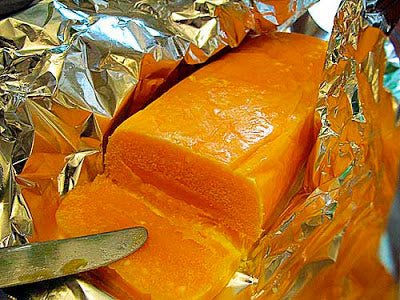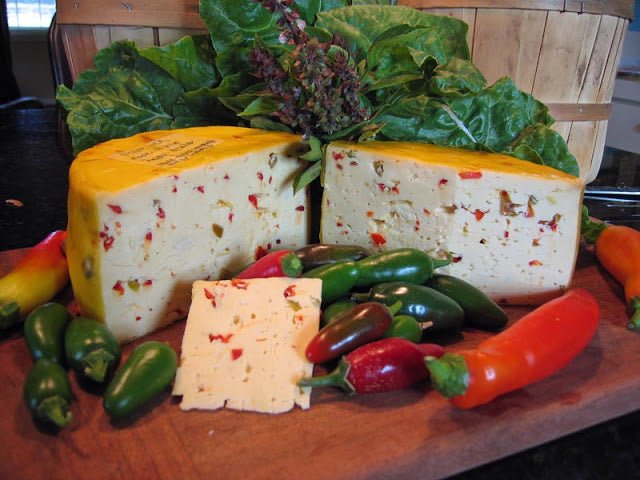Making Award-Winning Farmstead Gouda
Jonathan Wright has a vision. He dreams of artisan cheesemakers in his area sharing their resources to produce their cheeses more economically.
Within a fairly small geographical area, several cheesemakers would make their own special cheeses in the same place, using much of the same equipment, the same office workers, and the same marketing staff. They would raise their own herds, but they would simply carry their milk a few miles down the road to the “co-operative creamery.” Then, depending on the circumstances, they would either age their cheeses there or bring them back to their own “caves” to age.
Jon is already starting to work on this, because soon he will be making cheese one day a week at the old Grafton Village Cheese plant which is a few miles from his farm. (Grafton has moved most of their operation to Brattleboro.) Depending on how this works for him, we might be hearing more about his vision coming to fruition. We certainly hope so.
Meanwhile, Jon has a beautiful farm in the Green Mountains of Vermont, where he makes award winning farmstead Gouda. He has access to 560 acres of property, including 160 acres for haying and 45 organic acres for grazing. This land is conserved by the Vermont Land Trust and Jon has lifetime rights to the property. He owns his house, which is right in front of the store, his barn and 20 acres of meadows.
We joined Jon in his office and he graciously spent more than an hour answering our questions and telling us how it all started:
The adventure first began when Jon was a teenager in 1975. He stopped in, on a whim, to ask the Taylors if he could work for them as part of a work-study program at the prep school he was attending in Boston. The Taylors were milking 30-35 cows and selling their milk to a local creamery. They agreed, and 35 years later, he and the Taylors are still working together to conserve the land.
After Jon finished high school, the Taylors offered to sell him the farm, but Jon wasn’t ready. He knew he needed an education, so he enrolled at the University of Vermont Agricultural School. He ended up getting his degree in forest management. When he was finished, the Taylors asked him to construct a forest management plan for their property. By then, it was the mid-eighties and the farm was abandoned.
In 1989, Jon made the decision to work the farm with his then pregnant wife (they have since divorced). The Taylors gave him free rein and allowed them to live in the guest house, rent free.
He went to the bank with a crude business plan and managed to secure a loan for $20,000, which seemed huge at the time. With that, he bought whatever cheap cows he could find and some refurbished equipment. He used draft horses for much of the farm work.
Those were the lean years, when milk prices plummeted and none of the dairy farms were making any money. But the community and the Taylors were supportive and they managed to milk a motley herd of 70 cows, including Black Angus, Holsteins (that couldn’t walk), Jerseys and Brown Swiss.
Jon’s wife worked part-time and they had a farm stand. But, after several years, milk prices were still down and Jon was working so many hours that he didn’t have enough time to spend with his 3 daughters (who are now 19, 16 and 12). So, he began searching for a better whey to make a living.
He thought about bottling his own milk, but then he visited Marjorie Susman and Marian Pollack at the Orb Weaver Farm (at left) in New Haven, VT. He saw that they had a good quality of life, milking 10 Jerseys and making cheese. He was impressed.
However, at that time, there were only 12 cheese making operations in Vermont. (Now there are 48!) So, the banks didn’t quite know what to do with him.
He sold a group of his cows to build a plant and he hired Peter Dixon, a well known consultant to help get him started. He decided to raise Holsteins and Jerseys and to make Gouda. (Holsteins came originally from the Netherlands.)
Now, Jon has 7 full-time employees and a few part-timers. They milk 40-45 cows (a closed herd) and it all goes into the cheese (with the exception of the raw milk they are licensed to sell).
They sell their cheese online (www.taylorfarmvermont.com), in their farm store, and at many stores and co-ops in the New England area (listed on their website).
In their store, they stock a wide variety of cheeses from nearby farms, because Jon believes in supporting fellow cheesemakers.
They also sell their wildly popular Vermont Natural Rind Gouda. (When you see it there, I suggest you buy it, because it goes fast. Did I mention that it’s outrageously delicious?)
They have arts and crafts, baked goods, maple sugar products, jams and jellies, sauerkraut . . . In fact, while we were in the office, a local entrepreneur brought some of his products for Jon to sell.
It was a lot of fun visiting Taylor Farm and I hope you get a chance to go there. In fact, if you do make the trip, they have a weekend guest lodge you can stay in to make the experience even more memorable.
If you live near Brattleboro, you can buy their cheese at one of these two venues:
MAY thru NOVEMBER
9am – 2pm. Brattleboro Area Farmer’s Market. Taylor Farm Cheese is proud to be one of the many wonderful farm products available at this very friendly, energetic and enjoyable market! Live music and family fun every Saturday!
NOVEMBER, 2010
Brattleboro Area Winter Market. Post-oil-solutions will be hosting an INDOOR WINTER MARKET for farm products and craft vendors in southern Vermont! Located at the River Garden, 157 Main Street in Brattleboro, Vermont. The schedule is as follows: November 1, 8, 15, 22, 29, December 6, 20, 27, January 3 and 17, February 7 and 21, March 7 and 21.

























































































































































































